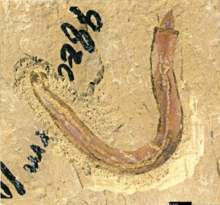Iotuba
| Iotuba Temporal range:
| |
|---|---|

| |
| Complete specimen of Iotuba from Chengjiang. | |

| |
| Reconstruction of Iotuba: head and anterior trunk | |
| Scientific classification | |
| Domain: | Eukaryota |
| Kingdom: | Animalia |
| Phylum: | incertae sedis |
| Genus: | †Iotuba |
| Species: | †I. chengjiangensis
|
| Binomial name | |
| †Iotuba chengjiangensis Zhang et Smith 2023 [1]
| |
Iotuba chengjiangensis (sometimes mis-spelt Lotuba[2]) is a 515 myo Cambrian worm known from the Chengjiang biota.[3] Originally interpreted as a phoronid, the organism is now recognized as an annelid cage worm affiliated with the Flabelligeridae and Acrocirridae, which Zhang et al grouped together in the new superfamily Flabelligeroidea.[1]
Anatomy[edit]
Iotuba was a couple of centimetres long and half a centimetre in width. Internally it is characterized by a through gut flanked by a pair of boudinaged tubes interpreted as nephridia ("kidneys"). Its trunk is adorned with small conical papillae ("microspines"). Its "head" bears a pair of tentaculate, horseshoe-shaped branchiae ("gills"), and can be withdrawn into the body; it is surrounded by a cage of spines interpreted as chaetae, equivalent to those of the flabelligerid "cage worms".[1]
History of interpretation[edit]
Iotuba was originally interpreted as a phoronid based on a misinterpretation of the single then-available specimen as harbouring a U-shaped gut and tentacles[4] – an interpretation that was soon thrown into question.[5] The holotype was independently named – by the same author – as Eophoronis, but as neither of these nomenclatural acts contained a diagnosis, they were invalid under the International Code of Zoological Nomenclature until formally defined by Zhang et al. in 2023.[1]
Previous comparisons to ecdysozoan worms such as Louisella.[6] have been ruled out based on the construction of the anterior region and other morphological detals.[1] Instead, the organism has been linked with the cirratliform annelids, specifically Flabelligeridae – an interpretation that fits in with morphological and molecular data in a phylogenetic context.[1]
Occurrence[edit]
Iotuba has been reported from the Chengjiang biota, with a possible additional occurrence in the Haiyan Lagerstätte[7]
References[edit]
- ^ a b c d e f Zhang, Zhifei; Smith, Martin R.; Ren, Xinyi (2023). "The Cambrian cirratuliform Iotuba denotes an early annelid radiation". Proceedings of the Royal Society B: Biological Sciences. 290 (1992). doi:10.1098/rspb.2022.2014. PMC 9890102. PMID 36722078.
- ^ Ma, Xiaoya; Hou, Xianguang; Baines, David (2010). "Phylogeny and evolutionary significance of vermiform animals from the Early Cambrian Chengjiang Lagerstätte". Science China Earth Sciences. 53 (12): 1774–1783. Bibcode:2010ScChD..53.1774M. doi:10.1007/s11430-010-4084-y. S2CID 84720166.
- ^ Ancient fossils shed new light on evolution of sea worm
- ^ Chen, J.-Y.; Zhou, G.-Q. (1997). "Biology of the Chengjiang Fauna". Bull. Natl. Museum Nat. Sci. 10: 11–105.
- ^ DY Huang; J Vannier; JY Chen (2004). "Anatomy and lifestyles of Early Cambrian priapulid worms exemplified by Corynetis and Anningvermis from the Maotianshan Shale (SW China)". Lethaia. 37: 21–33. doi:10.1080/00241160410005088.
- ^ Conway Morris, S. (2006). "Darwin's dilemma: the realities of the Cambrian 'explosion'". Philosophical Transactions of the Royal Society B: Biological Sciences. 361 (1470): 1069–1083. doi:10.1098/rstb.2006.1846. PMC 1578734. PMID 16754615.

- ^ Yang, Xianfeng; Kimmig, Julien; Zhai, Dayou; Liu, Yu; Kimmig, Sara R.; Peng, Shanchi (2021). "A juvenile-rich palaeocommunity of the lower Cambrian Chengjiang biota sheds light on palaeo-boom or palaeo-bust environments". Nature Ecology & Evolution. 5 (8): 1082–1090. doi:10.1038/s41559-021-01490-4. PMID 34183806. S2CID 235674619.
